Potential for increased phosphorus loading if inorganic supplements are used
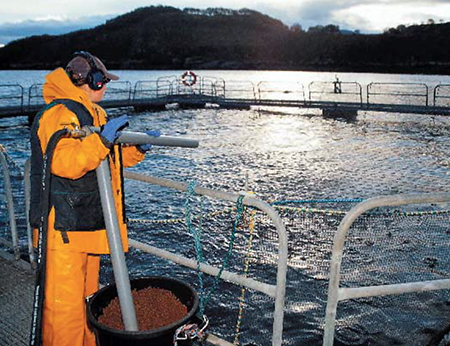
Plant meals are widely used in terrestrial animal feeds and often constitute up to 80 percent of some pelleted rations. Feeds based on soy, wheat, corn, rape, and many other crops support adequate growth and are well accepted by most farmed animals. They are also often cheaper than fishmeal, even on a protein equivalency basis.
Plant meals in aquaculture
In aquafeeds, plant meals have proven effective in supporting the desired feed pellet structure, although there have been numerous issues relating to growth performance in fish. Plant materials contain anti-nutritional factors that have adverse effects on digestive functioning and efficacy, including complex polysaccharides (e.g., fiber) with the ability to bind minerals and influence gastric emptying rate.
Of greater importance are the effects of trypsin-inhibitor proteins, glucosinolates and phytic acid – three antinutritional factors commonly associated with the most widely used plant materials. Heat-inactivation in meal production overcomes the trypsin-inhibitor activity in soybeans. Problems with glucosinolates in rapeseed have been solved through selective breeding. And the exogenous enzyme phytase is the best-known way to deal with the antinutritional activity of phytic acid.
Unlocking phosphorus
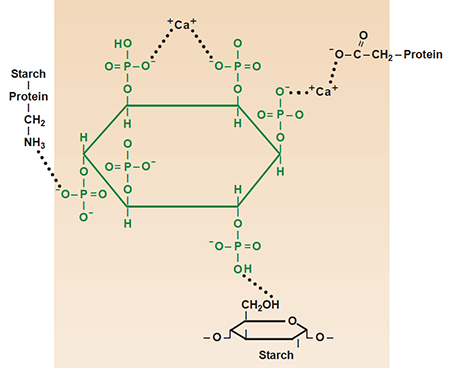
Phytic acid (Fig. 1) is found in all plants. It functions as a reservoir for minerals needed for plant growth. Typically, phytate-P (a P-salt) constitutes 40 to 90 percent of a plant’s total phosphorus. Using a phytase enzyme can release this unavailable phosphorus, making it available as a nutrient for terrestrial animals and fish.
Making phytate-P an available nutrient in aquafeeds can drastically reduce the need for inorganic phosphorus addition in plant-based rations. Reducing the need for supplemental P lowers P-discharge into the environment. The phytic acid breakdown caused by phytase can also liberate bound proteins and starches, with obvious benefits for production.
Phytase is a phosphatase enzyme with a specificity of action for the phosphate groups on the phytic acid structure, cleaving off those groups in a strict order. The efficacy of phytase functioning is dependent on the conditions of the reaction and the form of phytase used. The most effective form of phytase is one that causes the dephosphorylation of phytic acid starting from the 3-carbon position. This is known as 3-phytase.
Ensuring activity in feed

Enzymes are proteins whose activities are governed by temperature and pH, among other factors. The optimal temperature for microbial 3-phytase functioning is around 50 degrees C, with low in vitro activity below 5 degrees C (Figs. 2 and 3).
Pelleting temperatures greater than 85 degrees C destroy most phytase enzymes, so post-pelleting liquid application systems should be used to ensure that enzymes added to a feed survive to feeding. This technology is widely used in the manufacture of terrestrial animal feeds, and is becoming increasingly employed for aquafeed production, most notably for the application of oils and carotenoid pigments.
3-phytase works in salmonids
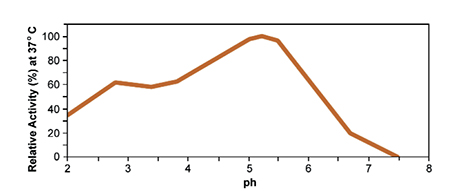
Despite the seemingly low in vitro phytase activity at culture temperatures encountered in salmonid aquaculture (5-15 degrees C), research results clearly indicate that phytase enzymes have a future in vegetable-based rations for fish. This is because the positive effect of phytase at low temperatures could be attributed to the much slower gut passage rate, and thus longer time for the enzyme and substrate to interact. In addition, high water activity in the gut is believed to be an influential factor in this process.
3-phytase trial with trout
A 63-day trial examined the effect of varying levels of 3-phytase on the phosphorus utilization of rainbow trout grown at 15 degrees C from 83 g to a final body weight of around 230 g. The trial employed five replicates per treatment. Diets were formulated to contain approximately 50 percent soy products. Table 1 shows diet formulation and proximate analysis.
Baker, Formulation and analysis of basal trout diet, Table 1
| Formulation | g/kg |
|---|
Formulation | g/kg |
|---|---|
| Soybean meal | 250 |
| Soy concentrate | 241 |
| Corn gluten meal | 79 |
| Corn starch | 99 |
| Fishmeal | 133 |
| Fish solubles | 40 |
| Fish oil | 124 |
| Premixes, binders, preservatives | 33.7 |
| Analysis | |
| Crude protein | 435 |
| Crude fat | 166 |
| Crude fiber | 20 |
| Crude ash | 57 |
| Ca | 8.4 |
| P. total | 5.3 |
| P. phytate | 3.2 |
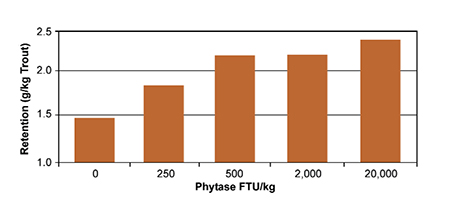
Levels of 3-phytase used in the diets were 0; 250; 500; 2,000; and 20,000 FTU per kilogram. One FTU of phytase activity is that amount of enzyme capable of liberating one micromole of orthophosphate from a 5.1-millimolar solution of sodium phytate in one minute at 37 degrees C and pH 5.5.
Fig. 4 shows that doses of 3-phytase between 250 and 2,000 FTU per kilogram significantly improved phosphorus retention in trout. The best effect was seen in treatments fed between 500 and 2,000 FTU per kilogram. Phosphorus excretion data revealed the reverse trend for retention, demonstrating that added phytase significantly reduced the phosphorus discharged into the water (Fig. 5).
Combining both retention and excretion data in an index of utilization efficiency showed that addition of 500 FTU 3-phytase per kilogram diet resulted in a 60 percent utilization of phosphorus. Groups not fed diets supplemented with 3-phytase utilized only around 40 percent of the total phosphorus.
Formulating for increased P availability
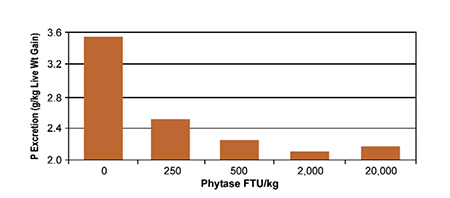
Forster et al. (1999) observed an increase in phytic acid digestibility when rainbow trout were fed levels of 3-phytase providing up to 4,500 FTU per kilogram in a rapeseed meal concentrate. At this high enzyme level, the phosphorus availability was significantly improved over a fishmeal control diet.
No growth-performance benefits were noted in this study because all diets were formulated to satisfy the 0.5 percent known requirement of available phosphorus without accounting for the P-equivalency associated with the activity of the 3-phytase. The formulation of rations using a phosphorus contribution from phytase should allow diets with minimal levels of added phosphorus, and thus reduce phosphorus discharge into the environment.
The results of Forster et al. (1999) compared well to those of Vielma et al. (1998), who also worked with trout, but fed soybean-based diets providing 0.26 percent available phosphorus (0.58 percent total P). Vielma noted that a 1,500 FTU 3-phytase per kilogram diet improved fish weight gain by 22 percent over an unsupplemented group. Added 3-phytase also improved the P availability from 46 percent to over 70 percent. This meant the 3-phytase-supplemented group received 0.4 percent available phosphorus, the nutritional requirement defined by Wilson et al. (1982).
Decreasing pond phosphorus loading
Closed ponds are prone to nutrient loading and resulting eutrophication. Reduced inputs on water phosphorus levels may not be observed in short-term pond trials due to the release of anaerobic phosphorus from the bottom mud, but accumulation of phosphorus should be reduced following long-term decreases in feed input.
Laboratory trials support the use of phytase in soybean-based channel catfish feeds. Jackson et al. (1996) applied doses of 3-phytase (post-pelleting) to supply up to 4,000 FTU per kilogram diet in a feed formulated using plant-based raw materials as the only protein source.
At the end of the 10-week feeding period – during which juvenile catfish grew tenfold from 6.5 g – fecal samples revealed that feeding 3-phytase had a positive effect in lowering fecal phosphorus and associated water load. Lowest fecal phosphorus levels were achieved in groups fed the highest phytase level. Above 500 FTU per kilogram, however, no positive effect was seen on bone ash or bone phosphorus.
Conclusion
Many aquafarms are under constant scrutiny regarding water quality of their effluents. This pressure is felt mostly by those using closed, or semi-closed systems such as ponds and freshwater lakes or lochs, but even coastal marine operations are being watched. In the future, aquafeeds are likely to depend on an increased inclusion of plant-based raw materials, with the potential for increased phosphorus loading if inorganic supplements are used to counter poor P availability from phytase.
This may be answered by the use of 3-phytase, unlocking potential phosphorus associated with the phytic acid molecule. This would enable the formulation of lowest-possible phosphorus rations, and thereby improve effluent quality while allowing maximum growth.
(Editor’s Note: This article was originally published in the April 2001 print edition of the Global Aquaculture Advocate.)
Now that you've finished reading the article ...
… we hope you’ll consider supporting our mission to document the evolution of the global aquaculture industry and share our vast network of contributors’ expansive knowledge every week.
By becoming a Global Seafood Alliance member, you’re ensuring that all of the pre-competitive work we do through member benefits, resources and events can continue. Individual membership costs just $50 a year. GSA individual and corporate members receive complimentary access to a series of GOAL virtual events beginning in April. Join now.
Not a GSA member? Join us.
Authors
-
-
F.J. Schöner, Ph.D.
BASF Aktiengesellschaft
Ludwigshafen, Germany -
Linda L. Smith-Lemmon
Rangen Aquaculture Research Center
Hagerman, Idaho, USA -
Bart Cousins, Ph.D.
BASF Corp.
Mount Olive, New Jersey, USA
Related Posts

Aquafeeds
A look at protease enzymes in crustacean nutrition
Food digestion involves digestive enzymes to break down polymeric macromolecules and facilitate nutrient absorption. Enzyme supplementation in aquafeeds is a major alternative to improve feed quality and nutrient digestibility, gut health, compensate digestive enzymes when needed, and may also improve immune responses.

Health & Welfare
Phytase supplementation in aquaculture diets improves fish, shrimp growth performance
Despite research challenges, ongoing work on phytase supplementation in shrimp is striving to enhance shrimp feed performance in similar ways.

Health & Welfare
Probiotics benefit three stages of juvenile rohu
Experiments were conducted to evaluate the potential survival and growth benefits of three multi-strain probiotics in three different stages of juvenile rohu (hatchling to advanced fry). Results showed beneficial effects of the probiotics treatments for the hatchling and fry stages, but not for later stages.

Intelligence
On GM foods, part 4: Let’s examine our needs
Scott Nichols concludes his four-part series about GM foods with a simple question about transgenic animals: Are they truly meeting a need? We need more food and we need better nutrition. Both desires should be achieved without increasing environmental impacts.


